Garmin 196 User Manual
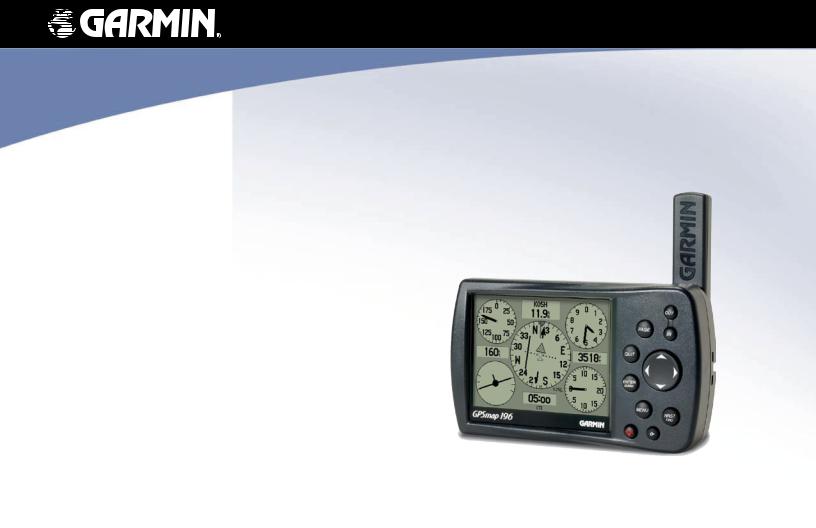
GPSMAP® 196
portable aviation receiver
pilot’s guide
© Copyright 2004, 2005 Garmin Ltd. or its subsidiaries
Garmin International, Inc.
1200 East 151st Street, Olathe, Kansas 66062, U.S.A. Tel. 913/397.8200 or 800/800.1020
Fax 913/397.8282
Garmin (Europe) Ltd.
Unit 5, The Quadrangle,Abbey Park Industrial Estate, Romsey, SO51 9DL, U.K. Tel. 44/0870.8501241
Fax 44/0870.8501251
Garmin Corporation
No. 68, Jangshu 2nd Road, Shijr, Taipei County, Taiwan Tel. 886/2.2642.9199
Fax 886/2.2642.9099
All rights reserved. Except as expressly provided herein, no part of this manual may be reproduced, copied, transmitted, disseminated, downloaded or stored in any storage medium, for any purpose without the express prior written consent of Garmin. Garmin hereby grants permission to download a single copy of this manual onto a hard drive or other electronic storage medium to be viewed and to print one copy of this manual or of any revision hereto, provided that such electronic or printed copy of this manual must contain the complete text of this copyright notice and provided further that any unauthorized commercial distribution of this manual or any revision hereto is strictly prohibited.
Information in this document is subject to change without notice. Garmin reserves the right to change or improve its products and to make changes in the content without obligation to notify any person or organization of such changes or improvements. Visit the Garmin Web site (www.garmin.com) for current updates and supplemental information concerning the use and operation of this and other Garmin products.
Garmin®, GPSMAP®,AutoLocate®, TracBack®, BlueChart®, and MapSource® are registered trademarks of Garmin Ltd. or its subsidiaries and may not be used without the express permission of Garmin.
August 2005 |
Part Number 190-00283-00 Rev. D |
Printed in Taiwan |

INTRODUCTION > ABOUT THIS MANUAL
INTRODUCTION
Thank you for choosing the Garmin GPSMAP® 196, an unsurpassed portable aviation receiver that utilizes the proven performance of Garmin GPS and full-featured mapping. Take a moment now to compare the contents of this package with the packing list on the outside of the box. If any pieces are missing, contact your Garmin dealer immediately.
About This Manual
To get the most out of your new navigation system, take time to read this manual and learn the operating procedures for your unit:
The Introduction contains the Table of Contents. The Getting Started section provides information such as an overview of unit features and how to turn the unit on and adjust the backlight.
The Basic Operation inAviation Mode section provides you with information about navigating with the GPSMAP 196 inAviation Mode. The Aviation Mode Pages section reviews, in detail, the main pages and features ofAviation Mode, such as the E6B.
The Basic Operation in Land Mode section provides you with information about navigating with the GPSMAP 196 in Land Mode. The Land Mode Pages section reviews in detail, the main pages and features in Land Mode, such as creating waypoints.
The Basic Operation in Water Mode section provides you with information about navigating with the GPSMAP 196 in Water Mode.
The Water Mode Pages section reviews the main pages and features in Water Mode. For complete information about some of the main pages and features in Water Mode, refer to theAviation and Land sections.
The Main Menu section describes pages and features found in the Main Menu.
The Appendix contains specifications, optional accessories, maintenance information, and other product information.
An Index is provided at the end of the manual for reference.
Manual Conventions
This manual uses the term Warning to indicate a potentially hazardous situation, which, if not avoided, could result in death or serious injury.
This manual uses the term Caution to indicate a potentially hazardous situation, which, if not avoided, may result in minor injury or property damage. It may also be used without the symbol to alert you to avoid unsafe practices.
GPSMAP196 Pilot’s Guide |
i |

INTRODUCTION > TABLE OF CONTENTS
Table of Contents |
|
Introduction........................................................................... |
i |
About This Manual................................................................... |
i |
Warning................................................................................... |
iv |
Caution..................................................................................... |
v |
Care Information .................................................................... |
vi |
Getting Started..................................................................... |
1 |
Unit Overview .......................................................................... |
1 |
Turning On the GPSMAP 196 ................................................. |
3 |
Getting Satellite Signals......................................................... |
4 |
Learning About the Keypad.................................................... |
7 |
Using the GPSMAP 196 .......................................................... |
8 |
Simulator Mode ..................................................................... |
11 |
Basic Operation In Aviation Mode ................................... |
13 |
Aviation Mode Page Sequence ............................................ |
13 |
Creating a Direct To .............................................................. |
14 |
Finding a Nearby Point......................................................... |
17 |
Selecting an Approach.......................................................... |
22 |
Finding Points on Land ........................................................ |
24 |
Marking a Waypoint............................................................... |
25 |
Creating a Flight Plan (Route).............................................. |
26 |
Following your Flight Plan ................................................... |
27 |
Aviation Mode Pages ........................................................ |
28 |
Map Page................................................................................ |
28 |
Panel Page............................................................................. |
36 |
Active Route Page................................................................. |
40 |
Position Data Page................................................................ |
41 |
Flight Log............................................................................... |
42 |
Aircraft Information............................................................... |
43 |
E6B Tab .................................................................................. |
46 |
Basic Operation In Land Mode......................................... |
48 |
Land Mode Page Sequence.................................................. |
48 |
Navigating in Land Mode...................................................... |
49 |
Finding an Item...................................................................... |
51 |
Creating Routes..................................................................... |
52 |
Creating Waypoints............................................................... |
55 |
Following a Land Route........................................................ |
58 |
Land Mode Pages and Features ...................................... |
59 |
Map Page................................................................................ |
59 |
Current Route Page............................................................... |
60 |
Position Data Page................................................................ |
61 |
Editing and Managing Routes.............................................. |
62 |
Editing and Managing Waypoints........................................ |
66 |
Managing Your Tracks .......................................................... |
73 |
ii |
GPSMAP196 Pilot’s Guide |

INTRODUCTION > TABLE OF CONTENTS
Basic Operation and Pages in Water Mode |
....................77 |
Water Mode Page Sequence................................................. |
77 |
Map Page................................................................................ |
78 |
Compass Page....................................................................... |
79 |
Main Menu.......................................................................... |
80 |
GPS Tab.................................................................................. |
80 |
Flights Tab ............................................................................. |
81 |
Route Tab............................................................................... |
81 |
Points Tab .............................................................................. |
81 |
Track Tab................................................................................ |
82 |
Trip Tab................................................................................... |
82 |
Aircraft Tab ............................................................................ |
83 |
Celestial Tab .......................................................................... |
83 |
Map Tab.................................................................................. |
87 |
Setup Tab ............................................................................... |
88 |
Appendix............................................................................ |
99 |
Specifications........................................................................ |
99 |
Optional Accessories.......................................................... |
100 |
Installation Information....................................................... |
101 |
Learning About GPS ........................................................... |
104 |
LORAN TD Setup................................................................. |
106 |
Map Datums and Location Formats .................................. |
108 |
Jeppesen Database Information........................................ |
109 |
Messages............................................................................. |
110 |
Data Field Options............................................................... |
112 |
License Agreement and Warranty ..................................... |
114 |
Index................................................................................. |
117 |
GPSMAP196 Pilot’s Guide |
iii |
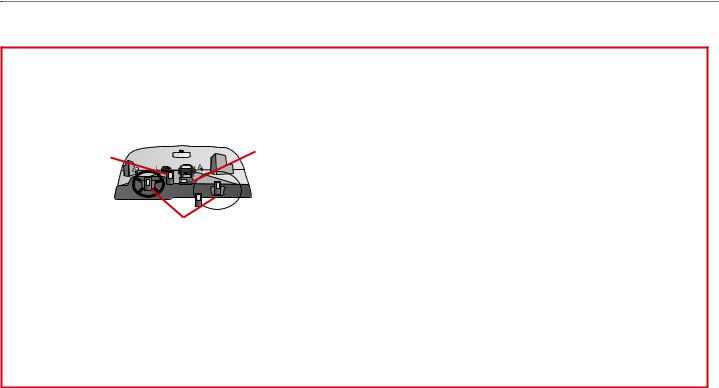
INTRODUCTION > WARNING
 Warning
Warning
Failure to avoid the following potentially hazardous situations could result in an accident or collision resulting in death or serious injury.
When installing the GPSMAP 196 in a vehicle, place the unit securely so that it does not interfere with vehicle operating controls or obstruct the driver’s view of the road (see diagram).
Do not mount |
Do not place |
where driver’s |
unsecured on |
field of vision is |
the vehicle |
blocked. |
dash. |
Do not mount in front of an airbag field of deployment.
Always operate the vehicle in a safe manner. Do not become distracted by the GPSMAP 196 while driving, and always be fully aware of all driving conditions. Minimize the amount of time spent viewing the screen of the GPSMAP 196 while driving and use voice prompts when possible. Do not enter destinations, change settings, or access any functions requiring prolonged use of the unit’s controls while driving. Pull over in a safe and legal manner before attempting such operations.
When navigating, carefully compare information shown on the GPSMAP 196 to all available navigation sources, including information
from street signs, visual sightings, and maps. For safety, always resolve any discrepancies or questions before continuing navigation.
Use the electronic chart in the GPSMAP 196 only to facilitate, not to replace, the use of authorized government charts. Official government charts and notices to mariners contain all information needed to navigate safely.
When navigating in an aircraft, use the GPSMAP 196 only as an aid for VFR navigation. Use obstacle data only as an aid to situational awareness.
WARNING: This product, its packaging, and its components contain chemicals known to the State of California to cause cancer, birth defects, or reproductive harm. This Notice is being provided in accordance with California’s Proposition 65. If you have any questions or would like additional information, refer to our Web site at http://www.garmin.com/prop65.
iv |
GPSMAP196 Pilot’s Guide |

|
|
INTRODUCTION > CAUTION |
|
Caution |
|
|
|
|
|
Failure to avoid the following potentially hazardous situations may |
The Global Positioning System (GPS) is operated by the United States |
|
result in injury or property damage. |
government, which is solely responsible for its accuracy and maintenance. |
|
The GPSMAP 196 is designed to provide you with route suggestions. It |
The government’s system is subject to changes which could affect |
|
the accuracy and performance of all GPS equipment, including the |
|
|
does not reflect road closures or road conditions, traffic congestion, weather |
|
|
GPSMAP 196.Although the GPSMAP 196 is a precision navigation device, |
|
|
conditions, or other factors that may affect safety or timing while driving. |
|
|
any navigation device can be misused or misinterpreted and, therefore, |
|
|
Use the GPSMAP 196 only as a navigational aid. Do not attempt to use the |
|
|
become unsafe. |
|
|
GPSMAP 196 for any purpose requiring precise measurement of direction, |
|
|
|
|
|
distance, location, or topography. This product should not be used to |
|
|
determine ground proximity for aircraft navigation. |
|
|
|
|
Map Data Information: One of the goals of Garmin is to provide customers with the most complete and accurate cartography that is available to us at a reasonable cost. We use a combination of governmental and private data sources, which we identify in product literature and copyright messages shown to the consumer. Virtually all data sources contain inaccurate or incomplete data to some extent. This is particularly true outside the United States, where complete and accurate digital data is either not available or prohibitively expensive.
GPSMAP196 Pilot’s Guide |
v |

INTRODUCTION > CARE INFORMATION
Care Information
To resolve problems that cannot be remedied using this guide, contact Garmin Product Support in the U.S.A. at 800/800.1020 or Garmin Europe at 44/0870.8501241.
Cleaning the Unit
The GPSMAP 196 is constructed of high quality materials and does not require user maintenance other than cleaning. Clean the unit using a cloth dampened with a mild detergent solution and then wipe dry.Avoid chemical cleaners and solvents that may damage plastic components.
Storing the GPSMAP 196
Do not store the GPSMAP 196 where prolonged exposure to temperature extremes can occur (such as in the trunk of a car) as permanent damage may result. User information, such as waypoints and routes, is retained in the unit’s memory without the need for external power. It is always a good practice to back up important user data by manually recording it or downloading it to a PC (transferring it to MapSource).
Immersing the Unit in Water
The GPSMAP 196 is waterproof to IEC Standard 60529 IPX7. It can withstand immersion in 1 meter of water for 30 minutes. Prolonged submersion can cause damage to the unit.After submersion, be certain to wipe and air dry the unit before reuse or charging.
vi |
GPSMAP196 Pilot’s Guide |
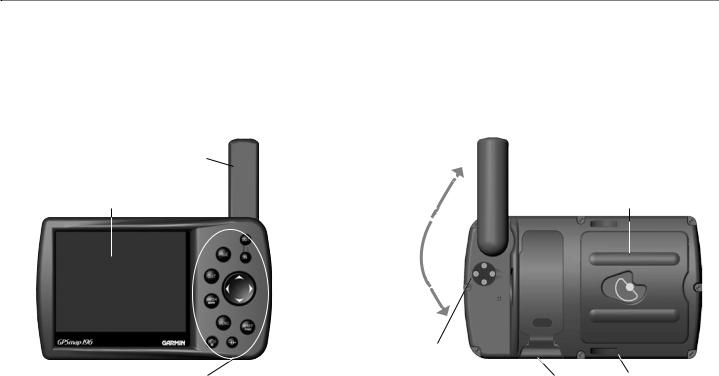
GETTING STARTED > UNIT OVERVIEW
GETTING STARTED
Unit Overview
The GPSMAP 196 is an all-in-one, versatile aviation, automotive, and marine navigator-perfect for air, land, or water. This portable GPS navigator features a built-in basemap, Jeppesen aviation database, U.S. obstacle database, and auto routing to provide you with automatically generated turn-by-turn directions.
GPS antenna
12-Level gray scale LCD display screen with backlight
Backlit keypad for easy nighttime operation
Detachable GPS antenna collapses for storage. Be sure the antenna is up (as shown here) to receive satellite signals. Refer to
the Appendix, page 103, for instructions on removing the antenna.
External power connector under weather cap
Battery compartment
Slot for optional |
Serial |
data card |
number |
GPSMAP196 Pilot’s Guide |
1 |
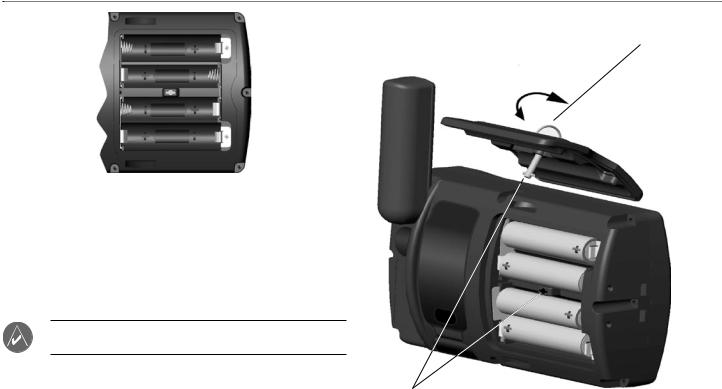
GETTING STARTED > UNIT OVERVIEW
To remove the battery lid, turn the D-ring 1/4 turn counterclockwise, and pull away.
The GPSMAP 196 uses 4AAbatteries, which can beAlkaline, rechargeable, Lithium, or Ni-Cad. Immediately after installing new batteries, turn the unit on to ensure that the unit’s power indicator shows a full charge. Replace all batteries at the same time. Do NOT mix new and used batteries. Do NOT mixAlkaline batteries with Lithium or Ni-Cad rechargeable batteries. When installing new batteries, observe the polarity markings in the case.
NOTE: The GPSMAP 196 saves user data in non-volatile memory. Data is not lost when the batteries are removed.
To reinstall the battery lid, place the locking pin into the unit and turn the D-ring 1/4 turn clockwise.
2 |
GPSMAP196 Pilot’s Guide |
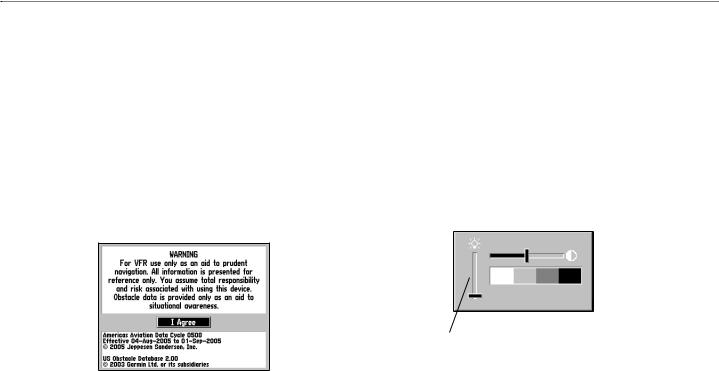
GETTING STARTED > TURNING ON THE GPSMAP 196
Turning On the GPSMAP 196
The first time you turn on your new GPSMAP 196, the receiver must collect satellite data and establish its present location. To ensure proper initialization, the GPSMAP 196 is shipped from the factory inAutoLocate mode, which allows the receiver to “find itself” anywhere in the world. Before you turn on the unit to start initialization, be sure that the antenna is rotated up as shown on page 1, and it has a clear and unobstructed view of the sky to receive satellite signals.
To turn on and off the GPSMAP 196:
1.Press and hold the POWER key. When the unit turns on, a tone sounds and the Warning Page appears.
Warning Page
2.Read and be sure you understand the warning. Press ENTER to continue.
3.To turn off the GPSMAP 196, press and hold the POWER key again.
Adjusting the Backlight and Volume
The POWER key controls the backlight and contrast of the screen.
To adjust the backlight and contrast level:
1.Press and quickly release the POWER key.
2.Press the ROCKER up to increase the brightness or down to decrease. Press right to increase the contrast or left to decrease.
3.Press ENTER or QUIT to close the Backlight/Contrast adjustment window. Press MENU to view the options menu.
 Contrast
Contrast
adjustment slider
Backlight adjustment slider
GPSMAP196 Pilot’s Guide |
3 |

GETTING STARTED > GETTING SATELLITE SIGNALS
Getting Satellite Signals
After you turn on the GPSMAP 196, the unit automatically begins searching for satellites. The GPS Page appears while the unit is gathering satellite signals and acquiring a fix. This process should take only a few minutes. While the GPSMAP 196 is getting satellite signals, the GPS Page shows the status as “Acquiring Satellites.”
It can take a few minutes to acquire satellites and show your current location on the map. Be patient as the unit acquires satellite data. To get signals more quickly, be sure the antenna is raised to the up location shown in the image on page 1.
GPS Tab
NOTE: While acquiring satellites, the Map Page can show the wrong location, such as China. This does not mean your unit has the wrong data loaded. The GPS receiver needs a few more minutes to acquire satellites and find your current location.
Viewing GPS Status With the GPS Tab
The GPS tab provides a visual reference of satellite acquisition, receiver status, and accuracy. The sky view and signal strength bars give an indication of what satellites are visible to the receiver and whether they are being tracked.
As the receiver locks onto satellites, a signal strength bar appears for each satellite in view, with the appropriate satellite number underneath each bar. The numbers shown below each bar represent the particular satellite that is being received. Numbers above 33 indicate WAAS satellites.
The sky view shows a birds-eye view of the location of each satellite relative to the receiver’s last known location. The outer circle represents the horizon (north up), the inner circle represents 45º above the horizon, and the center point represents a location directly overhead. You can also set the sky view to a Track Up configuration, causing the top of the sky view to align along your current track heading.
4 |
GPSMAP196 Pilot’s Guide |

GETTING STARTED > GETTING SATELLITE SIGNALS
Signal |
|
Receiver |
|
||
strength bars |
|
status field |
Sky view |
|
|
|
|
|
GPS Tab
The progress of satellite acquisition is shown in three stages:
•No signal strength bars—the receiver is looking for the satellites indicated.
•Grey signal strength bars—the receiver has found the satellite and is collecting data.
•Black signal strength bars—the receiver has collected the necessary data from this satellite.
As soon as the GPSMAP 196 has collected the necessary data from the best satellites in view to calculate a fix, the status field indicates the status of the receiver. The unit then updates the location, date and time.
Receiver Status
The Receiver Status field shows one of the following conditions:
•Searching the Sky—the receiver is looking for satellites.
•AutoLocate—the receiver is looking for any satellite whose almanac has been collected, which can take up to 5 minutes.
•Acquiring Satellites—the receiver is looking for and collecting data from satellites visible at its last known or initialized location, but has not acquired a fix.
•2D GPS Location—At least three satellites have been acquired and a two-dimensional location fix has been calculated. “2D Differential” appears when you are receiving DGPS corrections in 2D mode and a “D” appears on the strength bar of satellites being corrected.
•3D GPS Location—At least four satellites have been acquired and a three-dimensional fix has been calculated. “3D Differential” appears when you are receiving DGPS corrections in 3D mode and a “D” appears on the strength bar of satellites being corrected.
•Lost Satellite Reception—the receiver is no longer tracking enough satellites for a 2D or 3D fix.
•Receiver Not Usable—the receiver is unusable, possibly due to interference or abnormal satellite conditions. Turn the unit off and back on to reset.
•Simulating GPS—the receiver is in Simulator Mode.
•GPS Off—the GPS receiver is turned off.
GPSMAP196 Pilot’s Guide |
5 |

GETTING STARTED > GETTING SATELLITE SIGNALS
GPS Tab Options
Press MENU twice to open the Main Menu. Use the ROCKER to highlight GPS. Press MENU to open the options menu.
GPS Tab Options Menu
Start/Stop Simulator—starts and stops Simulator Mode, which is helpful when learning how to use your unit.
WAAS On—enables WAAS capability. Refer to page 105 of the “Appendix” for more information about WAAS.
Track/North Up Skyview—orients the sky view page on the GPS tab to north up or track up.
NewAltitude—allows you to manually enter your altitude.
New Location—allows you to enter a new location automatically or using the map.
GPS Tips
While the receiver is gathering information, your location on the map can show as different from where you actually are located. Be patient; as soon as the receiver gathers enough satellite information, your proper location is shown on the map.
Any time you have traveled more than 600 miles with the GPS receiver turned off, the receiver can take longer than normal to initialize and find your location.
The GPS receiver can lose satellite signals due to interference from such items as buildings, tunnels, and heavy tree cover. Monitoring the GPS status is recommended.
To learn about GPS, refer to “Learning about GPS” on page 104.
6 |
GPSMAP196 Pilot’s Guide |
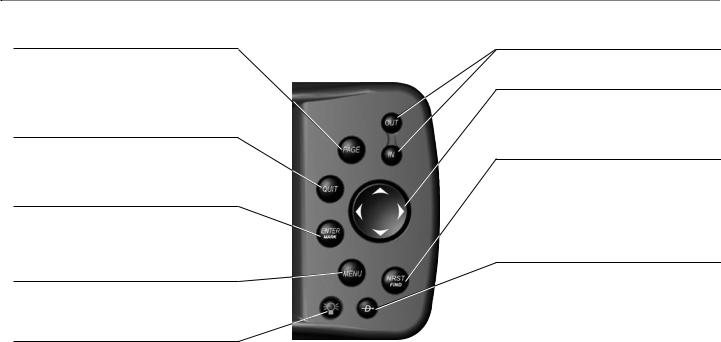
GETTING STARTED > LEARNING ABOUT THE KEYPAD
Learning About the Keypad
PAGE Key
•Press to cycle through the main pages in sequence and return the screen from a submenu page.
•Press and hold to switch betweenAviation, Land, and Water Modes.
QUIT Key
• Press to cycle through the main pages in reverse sequence, revert to the previous value in a data entry field, or cancel a function.
ENTER/MARK Key
• Press to select a highlighted option, initiate entry, and then confirm.
• Press and hold to mark a waypoint.
MENU Key
• Press to view the Options Menu for the current page.
• Press twice to show the Main Menu.
POWER Key
•Press and hold to turn the unit on or off.
•Press and release to adjust the backlighting and contrast.
IN/OUT Keys
•Press to zoom in or out on the Map Page.
ROCKER Keypad
•Press up, down, right or left to move through lists, highlight fields, on-screen buttons and icons, enter data, or move the map pointer.
NRST/FIND Key
•Shows the nearest airports, navaids, points of communication, and airspace boundaries in Aviation Mode.
•Press multiple times inAviation Mode to show the Find Menu.
DIRECTTO Key
•Press to start a Goto using airports, navaids, recently used waypoints, or user-created waypoints.
•Press and hold to show additional information for the current destination (such as communication frequency and runway data).
GPSMAP196 Pilot’s Guide |
7 |

GETTING STARTED > USING THE GPSMAP 196
Using the GPSMAP 196
This section explains how to enter and select information with the GPSMAP 196. To switch betweenAviation, Water, and Land Modes, press and hold PAGE. Use the ROCKER to select a mode, and press ENTER.
Understanding Terms
The GPSMAP 196 unit’s advanced keypad system is designed to allow quick, convenient selection of navigation options and data entry.As you progress through this Pilot’s Guide, you will often be directed to press a specific key or highlight a field on the screen. When you are directed to press a key, you should press and quickly release the key. If the key needs to be held down for a period of time to start a secondary function, the instructions tell you to do so. When a field is selected on the screen, it is highlighted in yellow. The location of the highlight is controlled by the ROCKER.
The following features are referred to throughout this manual:
Highlight—move the highlighted area on the screen up, down, left, or right with the ROCKER to select individual fields. Moving the highlight to a given location allows you to make a selection, begin data entry, or scroll through a list.
Field—the location on a page where data or an option can be entered and shown. Select (highlight) a field using the ROCKER to begin entering data or selecting options.
On-Screen Button—use the ROCKER to highlight a button and press ENTER to select the button.
Scroll Bar—when viewing a list of items too long to show on the screen, a scroll bar appears along the right side of the list. The location of the scroll bar indicates which portion of the list is currently shown. To scroll through a list, press up or down on the
ROCKER.
Default—the factory setting saved in the unit’s memory. You can change the settings as you like, but you can also revert to the factory (default) settings when you select Restore Defaults.
On-screen
buttons
8 |
GPSMAP196 Pilot’s Guide |
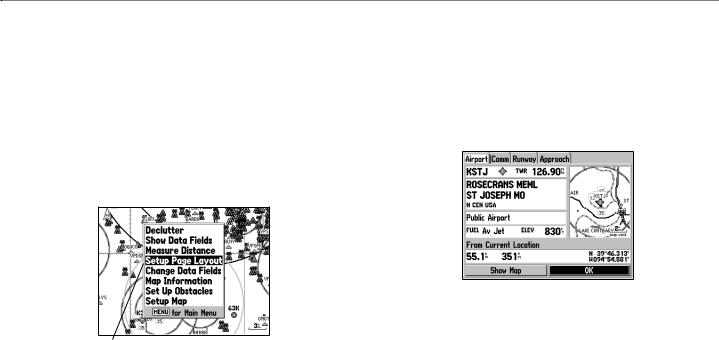
GETTING STARTED > USING THE GPSMAP 196
Selecting Options and Entering Data
To enter data and select options, you must use the ROCKER to highlight, select, or choose an item in a list or a field on the screen. Use the ENTER and ROCKER keys to select options, enter names and numbers in data fields, and start your selections.
To select and start an option:
1.Press MENU on any page. An options menu appears with a list of optional features for that page.
2.Use the ROCKER to move the highlight up, down, right, or left on the menu to your selection.
To exit a menu or return to the previous setting:
1.Press QUIT to move backward through your steps.
2.To return to the starting page, press QUIT repeatedly.
To select and start an on-screen button:
1.On a page with on-screen buttons, use the ROCKER to highlight the on-screen button you want.
2.Press ENTER.
On-screen button
Selecting an option from an options menu
GPSMAP196 Pilot’s Guide |
9 |

GETTING STARTED > USING THE GPSMAP 196
To enter data in a data field:
1.Use the ROCKER to highlight the data field you want, and press ENTER to activate the field.
2.Press up or down on the ROCKER to select characters. Press right to move to the next character or press left to move back to the previous character. If there are two lines of data, keep pressing right to drop to the next line.
3.After entering the data, press ENTER.
Entering data
NOTE: To clear the entire data field, highlight the left-most character field and press left once more on the ROCKER.
Not all fields are programmable. When you are on a page with fields that are not selectable, the highlight skips over them.
GPSMAP 196 Databases
Your GPSMAP 196 comes with a Jeppesen® database, an Obstacle database, and a basemap. You also should update your Jeppesen database to use the most current data. Refer to page 109 in the “Appendix” for more information.
MapSource Detailed Maps
Optional Garmin Data Cards and MapSource CD-ROMs enhance the versatility of your GPSMAP 196. With optional MapSource City Select® data, you can view listings of nearby restaurants, lodging, shopping centers, attractions, and entertainment, and even retrieve addresses and phone numbers for any listed location. With optional BlueChart data, you can access marine navaids, wrecks, obstructions, and anchorage locations.
The included PC Interface Cable (with a serial connector) is used to transfer MapSource CD-ROM data to the optional Data Card.
For compatible MapSource products, refer to the Garmin Web site at http://www.garmin.com/cartography/
10 |
GPSMAP196 Pilot’s Guide |
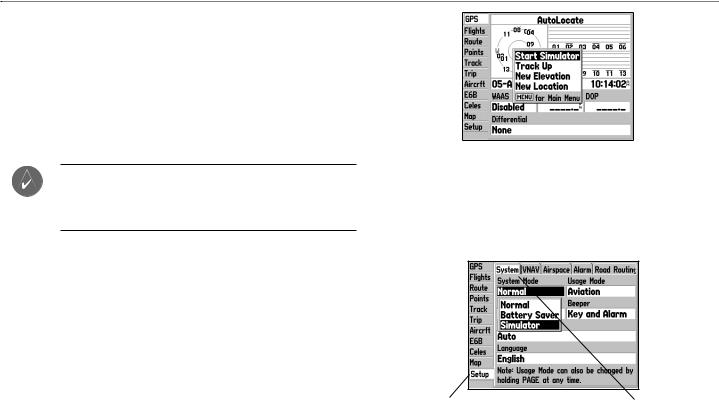
GETTING STARTED > SIMULATOR MODE
Simulator Mode
The GPSMAP 196 contains a Simulator Mode. Simulator Mode is helpful for practicing with the unit indoors or when no satellite signals are available or if the antenna is not connected.All waypoints and routes created in Simulator Mode are retained in memory for future use. The following section describes how to use
Simulator Mode and walks you through some basic navigation using the simulator.
NOTE: Do not attempt to navigate using Simulator Mode. When the unit is set to Simulator Mode, the GPS receiver is turned off. Any Satellite Signal Strength Bars shown are only simulations and do not represent the strength of actual satellite signals.
Starting Simulator Mode
You can start Simulator Mode for the GPS tab or the Setup tab on the Main Menu.
To start Simulator Mode using the GPS tab:
1.Press MENU twice to show the Main Menu.
2.Highlight GPS from the vertical menu.
3.Press MENU to open the GPS tab options menu.
4.Highlight Start Simulator, and press ENTER.
To start Simulator Mode using the Setup tab:
1.Press MENU twice to show the Main Menu.
2.Highlight Setup from the vertical menu.
3.Highlight the System sub tab.
4.Select Simulator from the System Mode field.
Setup tab of Main Menu |
System sub tab |
GPSMAP196 Pilot’s Guide |
11 |

GETTING STARTED > SIMULATOR MODE
Entering a New Location
From the GPS options menu you can enter a New Location and NewAltitude to simulate from.
To enter a New Location using the map:
1.Press MENU twice and highlight GPS from the vertical menu.
2.Press MENU to open the options menu.
3.Highlight New Location, and press ENTER.
4.Highlight Use Map, and press ENTER.
5.Use the ROCKER to move the panning arrow to the location on the map you want, and press ENTER.
To adjust the simulated speed, heading, and altitude from the Panel or HSI pages:
1.Press up on the ROCKER increase the speed in
10 knot/kph/mph increments. Press down on the ROCKER to decrease the speed in the same increments.
2.Press left or right on the ROCKER to change heading.
3.Press the IN and OUT Zoom keys to increase or decrease altitude (Aviation Mode only).
12 |
GPSMAP196 Pilot’s Guide |
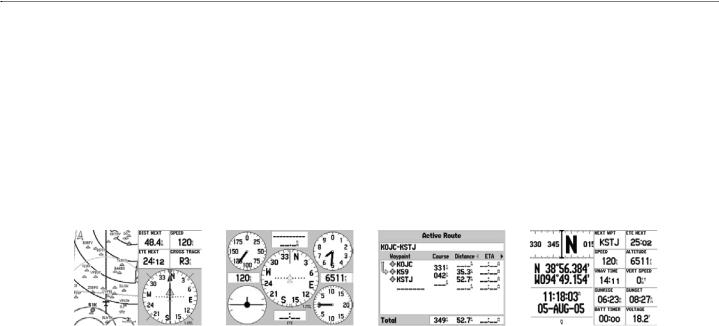
BASIC OPERATION IN AVIATION MODE > AVIATION MODE PAGE SEQUENCE
BASIC OPERATION IN AVIATION MODE
Aviation Mode Page Sequence
The GPSMAP 196 offers three usage modes,Aviation Mode (default), Land Mode, and Water Mode. The main pages are linked together in a series that you can cycle through by pressing PAGE to move forward and QUIT to reverse. Each page also has an options menu that allows you to customize each page (in all three modes) to your preferences and/or select features that specifically relate to that page. To view the options menu for any page, press MENU.
Aviation Mode features four main pages: Map Page, Panel Page,Active Route Page, and Position Data Page.An example of each page in Aviation Mode appears below. Each of these pages has a specific use and each page is discussed later in this manual.Aviation Mode is the default mode for the GPSMAP 196. This manual first addresses each page, such as the Map Page, as shown inAviation Mode. The manual then describes the page as shown in Land and Water Mode.
|
|
|
|
|
|
|
Map Page |
Panel Page |
Active Route Page |
|
Position Data Page |
||
To switch usage modes:
1.Press and hold PAGE.
2.Use the ROCKER to select Aviation, Land, or Water, and press ENTER.
GPSMAP196 Pilot’s Guide |
13 |
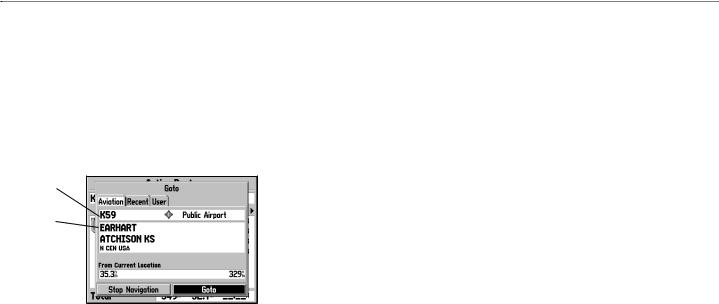
BASIC OPERATION IN AVIATION MODE > CREATING A DIRECT TO
Creating a Direct To
InAviation Mode, press Direct To  to select a destination. When a Goto or route is currently in use, holding Direct To
to select a destination. When a Goto or route is currently in use, holding Direct To  down briefly shows a detailed information page for the current destination.
down briefly shows a detailed information page for the current destination.
Press MENU on any tab of the Goto Page to open an options menu for that tab. Based on the tab you selected, you can Show Details,
SelectApproach, Select Route, Find Land Points, and Remove Point.
Airport
Identifier
Facility
Name
City
Goto Page: Aviation Tab
To goto an airport or navaid:
1.Press the Direct To  to show the Goto Page. Use the
to show the Goto Page. Use the
ROCKER to show the Aviation tab.
2.Press up or down on the ROCKER to select the identifier, facility name, or city field, and press ENTER.
3.Use the ROCKER to enter the word to search. Press up and down to change the highlighted character and right to move to the next character field. As you scroll through the characters the GPSMAP 196 shows database entries with the same characters you have entered to that point. If more than one entry exists in the database for the characters you have entered, a window appears. Use the ENTER key and the ROCKER to select the point.
4.Press ENTER when the point is shown.
5.With the on-screen Goto button highlighted, press ENTER. The GPSMAP 196 creates a course from your present location to the selected destination.
14 |
GPSMAP196 Pilot’s Guide |

BASIC OPERATION IN AVIATION MODE > CREATING A DIRECT TO
To goto a recently-used or user-created waypoint:
1.Press the Direct To  to show the Goto Page. Use the ROCKER to select the Recent or User tab.
to show the Goto Page. Use the ROCKER to select the Recent or User tab.
Goto Page: Recent Tab
2.Use the ROCKER to highlight the point from the list, and press ENTER.
From the User tab, you can also select the top waypoint name line and then spell out the waypoint name using the
ENTER key and the ROCKER.
3.Highlight the on-screen Goto button, and press ENTER. A course is plotted from your present location to the selected destination.
Viewing Details for the Destination
The Show Details option shows detailed information for your destination waypoint or the next waypoint in a route. This feature is handy for retrieving airport information, such as communication
frequencies and runway information. You can view details by using the options menu or by selecting Show Details on the Goto Page menu, and pressing ENTER.
To view the details for the selected destination:
1.Press MENU to open the options menu. Use the ROCKER to highlight Show Details, and press ENTER.
2.Use the ROCKER to select the tab to view the information.
Airport Tab of Details Page
3.Highlight Show Map, and press ENTER to view the item on the map. Press QUIT when done. Highlight OK, and press ENTER to return to the Goto Page.
GPSMAP196 Pilot’s Guide |
15 |

BASIC OPERATION IN AVIATION MODE > CREATING A DIRECT TO
When viewing information for the Runway orApproach tabs, use the ROCKER to highlight the runway designation or approach name, and press ENTER. Then press up or down on the ROCKER to scroll through available runways and approaches. Press ENTER to select the runway or approach for which you would like to view additional information.
Viewing Frequency Restrictions
The Comm tab on theAirport Details Page provides a list of communication frequencies for that airport. Some frequencies are noted with an asterisk (*), which indicates that the frequency has usage restrictions. You can show the usage restriction information on your GPSMAP 196.
To view usage restrictions for a communication frequency:
1.With the Comm tab selected, use the ROCKER to highlight any frequency with usage restrictions (noted with an asterisk), and press ENTER. A Usage Restrictions Page appears describing the restrictions for the selected frequency.
Usage Restrictions Page
2. To return to the Comm Information Page, press ENTER.
16 |
GPSMAP196 Pilot’s Guide |
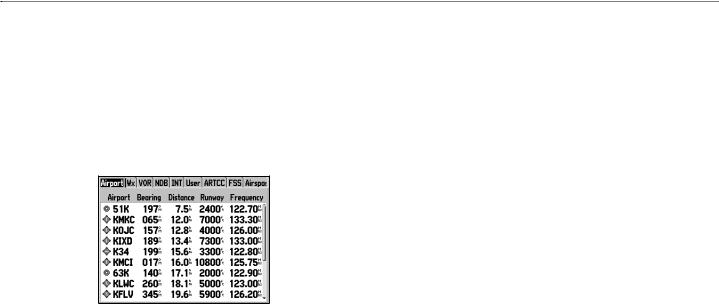
BASIC OPERATION IN AVIATION MODE > FINDING A NEARBY POINT
Finding a Nearby Point
InAviation Mode, press NRST/FIND to open the Nearest Pages. These pages provide detailed information on the nearest airports, airport weather sources, user waypoints within 200 miles of your present location, and other points.
In Water and Land Modes, press NRST/FIND to open the Find Menu. You can easily search waypoints, cities, exits, and tide stations using the Find Menu.
Nearest Page: Airport Tab
While in Aviation Mode
Press MENU when the Nearest Page is open to show the Nearest Page options menu. From the Nearest Page option menu, you can
SetAirport Criteria.
Aviation Nearest Categories
InAviation Mode, the Nearest Pages contains the following information:
Airport—nearest 15; identifier, bearing, distance, length of the longest runway, and common traffic advisory (CTAF) or tower frequency.
Wx (Airport Weather Sources)—nearest 15 airport weather information sources includingAWOS,ASOS, andATIS.
VOR (VHFOmnidirectional Radio Beacons)—nearest 15; identifier, facility type (symbol), bearing, distance, and frequency.
NDB (Non Directional Beacons)—nearest 15; identifier, facility type (symbol), bearing, distance, and frequency.
INT (Intersection)—nearest 15; identifier, bearing, and distance. User (Waypoints)—nearest 15; name, bearing, and distance.
ARTCC (Air Route Traffic Control Center)—nearest 5; bearing, distance, and frequency.
FSS (Flight Service Station)—nearest 5; bearing, distance, frequency, and VOR (for duplex operations).
Airspace—up to 15 (based on number of alerts provided); name, time to entry (when applicable), and status.
GPSMAP196 Pilot’s Guide |
17 |
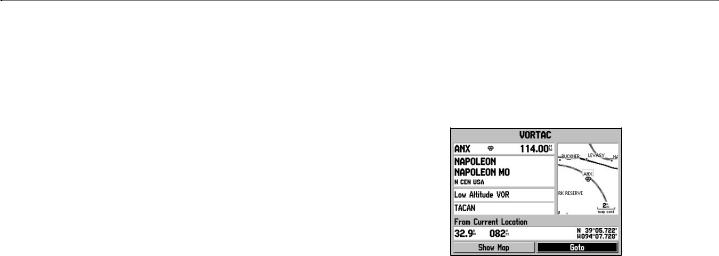
BASIC OPERATION IN AVIATION MODE > FINDING A NEARBY POINT
Selecting a Nearby Point as Your Destination
In an emergency, you can press a few keys to have the GPSMAP 196 guide you to the closest point to land.
To select a nearby point as your destination:
1.Press the NEAREST key.
2.Use the ROCKER to select the sub tab along the top of the page.
3.Highlight the point using the ROCKER.
4.Press Direct To  . The Goto Page opens for the selected point. Or you can press ENTER to show the Information Page (Details Page).
. The Goto Page opens for the selected point. Or you can press ENTER to show the Information Page (Details Page).
5.Press ENTER when Goto is highlighted.
To select the nearest airport as your destination:
1.Press NRST twice to show the Airport tab and highlight the nearest airport.
2.Press ENTER to view airport information.
3.Verify the Goto button is highlighted, and press ENTER.
Viewing Details for a Nearby Point
To view details for a nearby point:
1.Press NEAREST to show the nearest pages. Select the sub tab.
2.Use the ROCKER to highlight the item on the list and press ENTER. The corresponding information page appears.
Information Page for a VOR
On airport information pages, use the ROCKER to select the sub tabs across the top of the information pages and show the airport data.
3.Press QUIT to return to the Nearest Pages. You can also highlight any one of the on-screen buttons to perform that action, such as Show Map or Goto.
18 |
GPSMAP196 Pilot’s Guide |

BASIC OPERATION IN AVIATION MODE > FINDING A NEARBY POINT
Viewing Communication Frequencies
The Nearest Pages list up to five nearest flight service station (FSS) and air route traffic control center (ARTCC) points of communication. The closest communication point is shown first, with additional points available when selected. For duplex operation, the corresponding VOR is listed (by identifier) and the transmit and receive frequencies are denoted by a TX and RX respectively.
To view additional communication frequencies:
1.Press NEAREST to open the Nearest Pages.
2.Use the ROCKER to select the ARTCC or FSS sub tab.
3.Press the ROCKER down to highlight Center or Station (based which tab you are on), and press ENTER.
ARTCC Tab
4.Select the numbered item that you want from the list, and press ENTER to show the communication information. The lowest numbers on the list are the closest communication points.
Viewing Airspace Alert Information
When an airspace alert appears, press the NEAREST to automatically show nearby airspace information in theAirspace tab. This information includes name, time to entry (if applicable), and status. Normally, only one or two airspace alerts occur at a time, but with sectorized controlled airspace, such as many Class B areas, there are more. Status information can appear as follows:
Ahead—your projected course takes you inside an airspace within the next 10 minutes or less.
Near—you are within two nautical miles of an airspace but not projected to enter it.
Near &Ahead—you are within two nautical miles of an airspace and your current course takes you inside the airspace.
InsideAirspace—you are within the boundaries of the airspace.
GPSMAP196 Pilot’s Guide |
19 |

BASIC OPERATION IN AVIATION MODE > FINDING A NEARBY POINT
Viewing Additional Airspace Information
From the Nearest Pages, you can show additional airspace information, such as floor and ceiling limits or communication frequencies.
To view additional airspace information:
1.When an airspace alert appears, press NEAREST to show the Nearest Pages and the airspace information. If you are already viewing the Nearest Pages, use the ROCKER to select the Airspace tab.
2.Use the ROCKER to select the airspace alert entry on the page, and press ENTER. An information page opens to show the controlling agency, status, and floor/ceiling limits.
3.To show a communication frequency for the airspace, select the Frequencies button, and press ENTER.
To return to the Nearest Pages, select the OK button, and press ENTER.
NOTE: When an airspace alert appears, press NEAREST to automatically show nearest airspace information. Press NEAREST a second time to quickly show the nearest airports list. Press NEAREST a third time to show the Find Menu.
Nearest Pages: Airspace Tab
20 |
GPSMAP196 Pilot’s Guide |
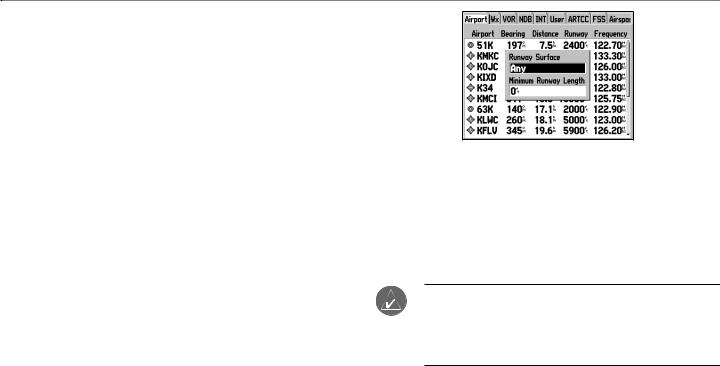
BASIC OPERATION IN AVIATION MODE > FINDING A NEARBY POINT
Setting Airport Criteria
From the NearestAirport tab, an options window allows you to filter out airports that do not meet a defined criteria. This allows you to only show airports with a surface type and sufficient runway length you want.
Runway Surface—allows you to set criteria for the type of surface on the runway:
Any—shows any runway, regardless of surface type, including water landing facilities.
Hard Only—shows only runways with a concrete, asphalt, or similar sealed surface.
Hard or Soft—shows all runways except water landing facilities. Water Only—shows only water landing facilities.
Minimum Runway Length—allows you to enter a specific length for the shortest runway allowed.
To enter airport criteria:
1.Press NEAREST, and open the Airport tab.
2.Press MENU to show the options menu.
3.Select Set Airport Criteria, and then press ENTER. A window appears with the current settings for runway surface and minimum runway length.
Airport Criteria Page
4.With the runway surface field highlighted, press ENTER. Select the surface type, and press ENTER.
5.Highlight the minimum runway length field, and press
ENTER.
6.Use the ROCKER to enter the minimum acceptable runway length. Press ENTER.
NOTE: Use caution when changing the nearest airport criteria. In an emergency, a short runway is still typically preferable
to an off-field landing. If you set the runway length too low or exclude many runway surfaces, you may not be alerted to a nearby airport that would be listed otherwise.
GPSMAP196 Pilot’s Guide |
21 |
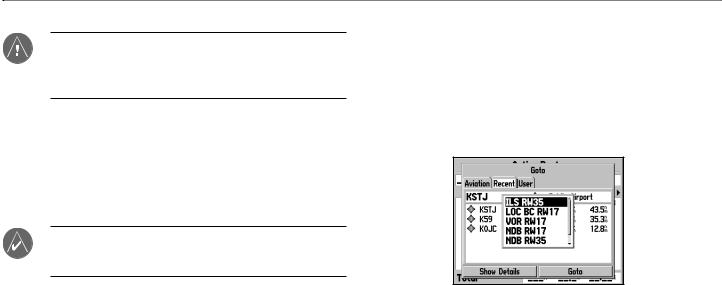
BASIC OPERATION IN AVIATION MODE > SELECTING AN APPROACH
Selecting an Approach
CAUTION: The approaches provided in the Jeppesen database are for monitoring purposes only. The GPSMAP 196 is not an IFR-approved instrument and should not be used as a primary source of navigation guidance in instrument conditions.
When you select an approach, it replaces the destination airport with the sequence of waypoints for the selected approach. Keep in mind that the airport must have a published approach (GPS, RNAV, VOR, NDB, localizer, or ILS) and only the final course segment (usually from final approach fix to missed approach point) of the published approach is available in the GPSMAP 196.
NOTE: When using a route, the selected approach for the destination airport overrides your current route. The original route is saved in the Route tab.
You can select an approach several ways:
•Press the Direct To  and press MENU on the Goto Page, as described in the steps to the right.
and press MENU on the Goto Page, as described in the steps to the right.
•From theActive Goto (orActive Route) Page, press MENU.
•From theAirport Details Page, select theApproach tab.
To select an approach for the destination airport:
1.Press the Direct To  to show the Goto Page. Select the destination you want to travel to.
to show the Goto Page. Select the destination you want to travel to.
2.Press MENU to open the options menu. Highlight Select Approach, and press ENTER.
3.Use the ROCKER to select the approach from the window, and press ENTER. A Vectors? window appears. See the following page for more information on vectors.
Selecting an Approach
4.Use the ROCKER to select Yes or No, and press ENTER. The GPSMAP 196 removes the destination airport from the Goto and replaces it with the approach waypoints.
22 |
GPSMAP196 Pilot’s Guide |
